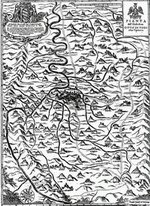Todi's country
Fratta Todina
The village of Fratta Todina is situated on a hill overlooking the site where the Faena River joins the Tiber, on the same hill where a village which Plinio called Tudernum probably once stood. Eleven kilometres outside of Todi, Fratta Todina is the smallest township in the district and one of the smallest in the entire region. It has only 1,732 inhabitants.
The countryside surrounding the actual town is built up with houses here and there, and also many isolated farms. In the Liber focularium or "the book of fires" written by board of Tuderte in 1290, the town was listed as Villa or Fracta Episcopi, the "thicket of the bishop". It was, in other words, the area where the bishop owned a great deal of land, and later, a place where he could go and rest in his free time or holidays. Because of its geographical position, Fratta was the object of fighting between Todi and Perugia, both of which sought to have control of the territory on the other side of the Tiber. In 1310, in fact, there was a great battle outside of Montemolino which resulted in a complete victory for Perugia.
During the battle Perugia destroyed the Montemolino bridge, using the stones it had thus acquired to reinforce various towers in Torgiano. Fratta remained, nevertheless, under the jurisdiction of Todi and its bishop. In 1416 Braccio Fortebraccio da Montone, general vicar of the church, lord of Perugia and Todi, Count of Capua and High Constable of Kingdom of Naples, enlarged and fortified the castle of Fratta Todina in order to make it a safer place for his troops to spend the winter and for himself to rest. In the XVI century the bishop had a splendid villa erected. A century later the villa was further enhanced by the building of a number of precious "water games" or fountains commissioned by the cardinal Altieri, who served also as the bishop of Todi.
The "games" designed by the architect Ludovico Gattelli, were an incredible feat of hydraulic engineering. Fratta, therefore, became sort of a country retreat for well-to-do Todi families, and remained so for all of the 1700's. It was there thet these families gathered for holidays and the big feast days of the harvest season in October. In 1800 the town began to depend economically on Marsciano, to the point, in fact, that it was referred to as Fratta di Marsciano.
It was not until 1846 that the town reassumed its original name of Fratta Todina, and, officially, it was not until 1860 that the town assumed its title of an independent township with the annexation of the region of Umbria to the Kingdom of Italy. The Convent of the Spineta is located not far from the center of the town. It is one of the most suggestive examples of the Franciscan tradition, and one finds it mentioned in many of the ancient legends of that order.



Fratta Todina
Sorge su una collina, alla confluenza del torrente Faena con il Tevere, probabilmente nel territorio dove esisteva un villaggio che Plinio chiamava Tudernum. Intorno al paese gravita un territorio ove l'insediamento si disperde in piccoli agglomerati o case isolate. Per la sua posizione geografica fu contesa fra Todi e Perugia che tentava di aver il controllo dei territori al di là del Tevere.
Nel 1800 il paese gravitò economicamente su Marsciano tanto che fu detta " Fratta di Marsciano", almeno fino al 1846, quando tornò ad essere Fratta di Todi ed infine, dopo l'annessione dell'Umbria al Regno d'Italia, nel 1860 divenne Comune con il titolo di Fratta Todina. Poco lontano dal centro abitato sorge il Convento della Spineta, uno dei luoghi più suggestivi della tradizione francescana, legato com'è alle sue più antiche vicende.
La visita alla città permette di apprezzare importanti monumenti che negli ultimi anni sono stati restaurati: le mura castellane costruite nel XIII e XIV sec.il Palazzo vescovile, la Chiesa Parrocchiale, la sede municipale e quella che era residenza del Cardinale Altieri, oggi sede privata.
